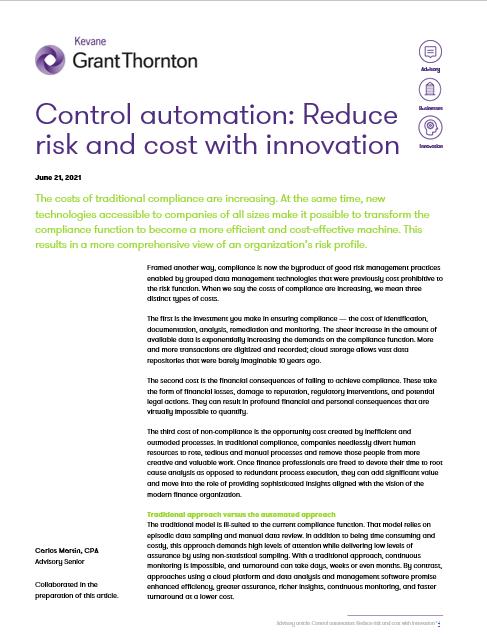-
Financial statements audits
Financial statement audits
-
Compliance audits
Compliance audits
-
Compilations and reviews
Compilations and audit
-
Agreed-upon procedures
Agreed-upon procedures
-
Corporate and business tax
Our trusted teams can prepare corporate tax files and ruling requests, support you with deferrals, accounting procedures and legitimate tax benefits.
-
International tax
Our teams have in-depth knowledge of the relationship between domestic and international tax laws.
-
Tax compliance
Business Tax
-
Individual taxes
Individual taxes
-
Estate and succession planning
Estate and succession planning
-
Global mobility services
Through our global organisation of member firms, we support both companies and individuals, providing insightful solutions to minimise the tax burden for both parties.
-
Sales and use tax and indirect taxes
SUT/ VAT & indirect taxes
-
Tax incentives program
Tax incentives program
-
Transfer Pricing Study
The laws surrounding transfer pricing are becoming ever more complex, as tax affairs of multinational companies are facing scrutiny from media, regulators and the public

-
Business consulting
Our business consulting services can help you improve your operational performance and productivity, adding value throughout your growth life cycle.
-
Forensic and investigative services
At Grant Thornton, we have a wealth of knowledge in forensic services and can support you with issues such as dispute resolution, fraud and insurance claims.
-
Fraud and investigations
The commercial landscape is changing fast. An ever more regulated environment means organizations today must adopt stringent governance and compliance processes. As business has become global, organizations need to adapt to deal with multi-jurisdictional investigations, litigation, and dispute resolution, address the threat of cyber-attack and at the same time protect the organization’s value.
-
Dispute resolutions
Our independent experts are experienced in advising on civil and criminal matters involving contract breaches, partnership disputes, auditor negligence, shareholder disputes and company valuations, disputes for corporates, the public sector and individuals. We act in all forms of dispute resolution, including litigation, arbitration, and mediation.
-
Business risk services
We can help you identify, understand and manage potential risks to safeguard your business and comply with regulatory requirements.
-
Internal audit
We work with our clients to assess their corporate level risk, identify areas of greatest risk and develop appropriate work plans and audit programs to mitigate these risks.
-
Service organization reports
As a service organization, you know how important it is to produce a report for your customers and their auditors that instills confidence and enhances their trust in your services. Grant Thornton Advisory professionals can help you determine which report(s) will satisfy your customers’ needs and provide relevant information to your customers and customers’ auditors that will be a business benefit to you.
-
Transactional advisory services
Transactions are significant events in the life of a business – a successful deal that can have a lasting impact on the future shape of the organizations involved. Because the stakes are high for both buyers and sellers, experience, determination and pragmatism are required to bring deals safely through to conclusion.
-
Mergers and acquisitions
Globalization and company growth ambitions are driving an increase in M&A activity worldwide as businesses look to establish a footprint in countries beyond their own. Even within their own regions, many businesses feel the pressure to acquire in order to establish a strategic presence in new markets, such as those being created by rapid technological innovation.
-
Valuations
We can support you throughout the transaction process – helping achieve the best possible outcome at the point of the transaction and in the longer term.
-
Recovery and reorganization
We provide a wide range of services to recovery and reorganisation professionals, companies and their stakeholders.
Framed another way, compliance is now the byproduct of good risk management practices enabled by grouped data management technologies that were previously cost prohibitive to the risk function. When we say the costs of compliance are increasing, we mean three distinct types of costs.
The first is the investment you make in ensuring compliance — the cost of identification, documentation, analysis, remediation and monitoring. The sheer increase in the amount of available data is exponentially increasing the demands on the compliance function. More and more transactions are digitized and recorded; cloud storage allows vast data repositories that were barely imaginable 10 years ago.
The second cost is the financial consequences of failing to achieve compliance. These take the form of financial losses, damage to reputation, regulatory interventions, and potential legal actions. They can result in profound financial and personal consequences that are virtually impossible to quantify.
The third cost of non-compliance is the opportunity cost created by inefficient and outmoded processes. In traditional compliance, companies needlessly divert human resources to rote, tedious and manual processes and remove those people from more creative and valuable work. Once finance professionals are freed to devote their time to root cause analysis as opposed to redundant process execution, they can add significant value and move into the role of providing sophisticated insights aligned with the vision of the modern finance organization.
Traditional approach versus the automated approach
The traditional model is ill-suited to the current compliance function. That model relies on episodic data sampling and manual data review. In addition to being time consuming and costly, this approach demands high levels of attention while delivering low levels of assurance by using non-statistical sampling. With a traditional approach, continuous monitoring is impossible, and turnaround can take days, weeks or even months. By contrast, approaches using a cloud platform and data analysis and management software promise enhanced efficiency, greater assurance, richer insights, continuous monitoring, and faster turnaround at a lower cost.
You can increase efficiency by up to 80% by automating the process and eliminating human error, which is a greater risk in rote processes. The benefits that automation can deliver in this approach are powerful, and they are compounded by the benefits that trained people can deliver. By freeing your people to concentrate on root cause analysis and gathering insights, you put them in a position to creatively solve problems and proactively add value. This could mean faster or more profound insights that can lead to quick action. It could also lead to evolving the control environment itself — adjusting controls to increase their precision, relevance, responsiveness, efficiency, and reliability.
Automation is a digital process that works best when the underlying process is also digital. Without a digitized process, it is hard for the team to automate testing activities consistently.
Control automation can help you achieve measurable efficiencies and generate actionable insights. While its implementation requires a commitment in rethinking your approach as well as training and technology, the costs of control automation decisively outweigh the costs of compliance as usual. While each compliance challenge requires its own array of software, there is fortunately plenty available. Regardless of the size of your company’s footprint, the right professionals can help you assess and automate your compliance controls, working with you to drive significant efficiencies and greater transparency across the compliance function.
Source: Grant Thornton library articles
